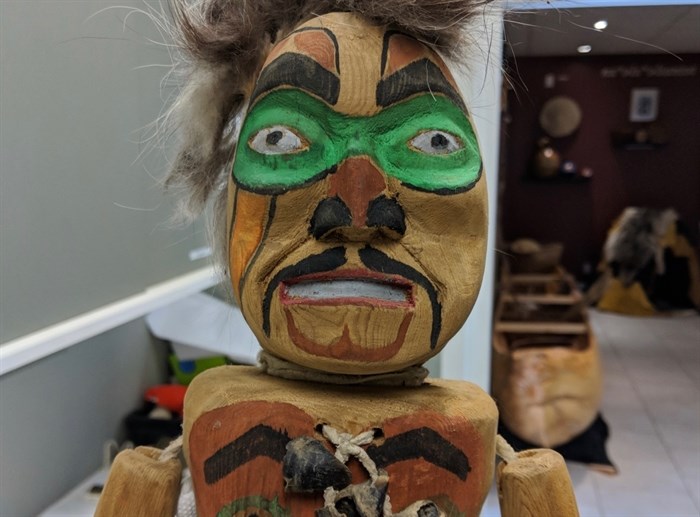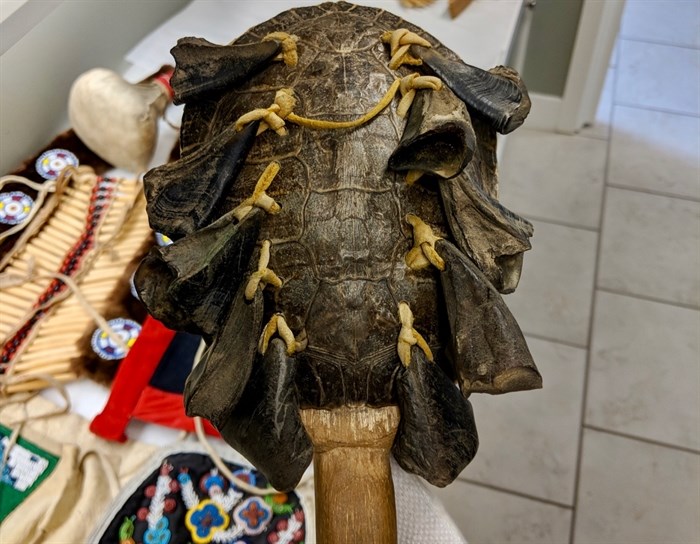
An item from the Oliver Jackson collection at the Sncewips Heritage Museum in the Westbank First Nation.
Image Credit: SUBMITTED/Sncewips Heritage Museum
August 10, 2018 - 9:00 PM
WESTBANK FIRST NATION - A Kelowna man who made and wore elaborate indigenous costumes but who was himself white has given the Sncewips Heritage Museum a chance to tackle cultural appropriation head on.
Sncewips is nearing the end of process that began several years ago when the Kelowna Museum approached the organization with a request, cultural adminstrator Jordon Coble recalls: Would Sncewips be interested in taking over the Oliver Jackson collection?
“They were struggling with how to tell the story because essentially it is mostly a First Nation representation of items created by a non-First Nations person,” Coble says. "It turned out to be a positive story."
Long-time locals may recall Jackson’s Hall Road museum that entertained tourists as well as busloads of schoolchildren on field trips from the late 1950s until 1981.
Jackson was a British immigrant to Canada who was enthralled by indigenous cultures from an early age, making his first costume as young boy after learning to sew and embroider from his mother. He also learned carving, beadwork and painting, which he employed in his creations.
“He gained a passion and apprecation for First Nations culture that he developed his whole life,” Coble says.

An item from the Oliver Jackson collection at the Sncewips Heritage Museum in the Westbank First Nation.
Image Credit: SUBMITTED/Sncewips Heritage Museum
He eventually settled with his wife in Rutland where he continued his fascination and honed his craft. His detailed costumes were soon in demand for various regattas, parades and pageants where Jackson himself would often dress up as an Indian chieftain.
Despite this, Coble says Jackson’s fascination was genuine, if sometimes misguided during his representations.
“He had teepees right next to totem poles, things like that, but he was very talented and he had first-hand relationships with various nations and communities from the Plains to the Coast,” Coble says.
All this makes the subject of cultural appropriation that much more complicated, Coble adds, but one that’s ultimately positive.
"This still gets people coming in. When we first started looking at Jackson’s collection, we found more appreciation and authenticity than we assumed,” Coble says. “Some of our elders remember working with him and sometimes borrowing items from him."
It’s been over a year now since the process began of receiving and unpacking the 2,000 items in the Jackson collection.
The donation essentially doubles the size of the museum’s archives, although there is far from enough space to display it all, Coble says, and a permanent space crunch means it will be years before the collection is fully displayed.
To contact a reporter for this story, email John McDonald or call 250-808-0143 or email the editor. You can also submit photos, videos or news tips to the newsroom and be entered to win a monthly prize draw.
We welcome your comments and opinions on our stories but play nice. We won't censor or delete comments unless they contain off-topic statements or links, unnecessary vulgarity, false facts, spam or obviously fake profiles. If you have any concerns about what you see in comments, email the editor in the link above.
News from © iNFOnews, 2018